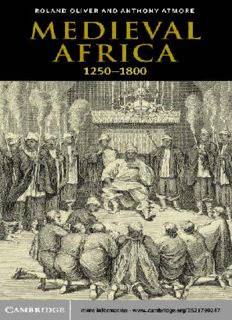
Medieval Africa, 1250 - 1800 PDF
Preview Medieval Africa, 1250 - 1800
This page intentionally left blank MedievalAfrica,– ThisisaradicallyrevisedandupdatededitionofTheAfricanMiddleAges – (first published in ), a companion volume to the authors’ well-known Africa since (now in its fourth edition). Although this volumefollowstheoverallplanoftheoriginal,thestorynowbegins yearsearlier,andtakesintoaccountthewealthofsupportiveliteraturein African historical studies over the last twenty years. The earlier starting datehasenabledtheauthorstolookattheentirecontinentfromamore distinctly African viewpoint. By about African societies were greatlyexpandingtheirpoliticalandeconomicscope.Islamwasspreading southacrosstheSaharafromMediterraneanAfrica,anddowntheIndian Oceancoast.MedievalAfricacontinuesintotheperiodofEuropeancon- tactsfromthefourteenthcenturyonwards,withmuch,butnotexclusive, emphasisonthegrowthofthetrans-Saharan,AtlanticandIndianOcean slave trade. The book stresses the strengths, while not overlooking the weaknesses,ofAfricansocietiesastheeighteenthcenturydrewtoaclose. This volume will be an essential introduction to African history for stu- dents, as well as for the general reader. It is illustrated with a wealth of maps. is Professor Emeritus of African History at the UniversityofLondon,andmemberoftheBritishAcademy.Hehaspub- lishedwidelyonAfricanhistory,includingAShortHistoryofAfrica(, translated into languages, revised editions), The African Experience (,revised)andIntheRealmsofGold(). has taught African history in both the UK and Africa.Heistheco-authorofthecompaniontothisvolume,Africasince (withRolandOliver,editionssince). Medieval Africa, – ROLAND OLIVER ANTHONY ATMORE The Pitt Building, Trumpington Street, Cambridge, United Kingdom The Edinburgh Building, Cambridge CB2 2RU, UK 40 West 20th Street, New York, NY 10011-4211, USA 477 Williamstown Road, Port Melbourne, VIC 3207, Australia Ruiz de Alarcón 13, 28014 Madrid, Spain Dock House, The Waterfront, Cape Town 8001, South Africa http://www.cambridge.org ©Cambridge University Press 2004 First published in printed format 2001 ISBN 0-511-03129-7 eBook (Adobe Reader) ISBN 0-521-79024-7 hardback ISBN 0-521-79372-6 paperback Contents Listofmaps pagevi Preface vii Introduction:themedievalscene Egypt:al-Misr IfriqiyaandtheRegencies TheIslamicFarWest:Morocco ThewesternSudanandupperGuinea ThecentralSudanandlowerGuinea Nubia,DarfurandWadai Thenorth-easterntriangle TheupperNilebasinandtheEastAfricanplateau TheheartofAfrica Thelandoftheblacksmithkings FromtheLualabatotheZambezi TheapproachestoZimbabwe ThepeoplesoftheSouth Epilogue Furtherreading Index v Maps Africa:geography,rainfallandvegetation pageviii IndianOceantradingactivities,– MuslimandChristianNorth-EastAfrica,– Egypt,theMaghribandtheSaharantraderoutes, – ‒ TheMaghrib,theSaharaandtheSudan,– MoroccoandthewesternSudan,– WestAfrica,– ThewesternSudan,upperandlowerGuinea,– ‒ ThecentralSudanandlowerGuinea,– ‒ EgyptandtheNiloticSudan,– FromtheNigertotheNile,– TheHornofAfricaintheageoftheSolomonids TheMuslimcounter-offensiveintheHorn TheimpactoftheOromoinNorth-EastAfrica TheupperNilebasinandtheEastAfricanplateau:the distributionoflanguage-families,c. TheupperNilebasinandtheEastAfricanplateau: languagesandcultures,c.– TheupperNilebasinandtheEastAfricanplateau: laterIronAgepopulationmovements,c.– TheupperNilebasinandtheEastAfricanplateau: settlementsoftheNilotes,c.– NorthernCentralAfrica ‒ WesternCentralAfrica FromtheLualabatotheZambezi ‒ TheapproachestoZimbabwe BetweentheZambeziandtheLimpopo SouthernAfrica ‒ vi Preface This book has emerged in response to an invitation by Cambridge UniversityPresstoprepareaRevisedEditionofTheAfricanMiddle Ages–publishedbythemin.Wefeltthataftersolong anintervalthedegreeofrevisionneededtoberadicalandthatthis mightbebestachievedbysettinganearlierstartingdateforthework as a whole. On the one hand this would enable us to look at the entire continent from a more distinctively African viewpoint, free fromthebiasinevitablyimpartedbythereliancefromtheoutseton European written sources. On the other hand it would ensure that eachofourregionalchapters,thestrongestnolessthantheweakest, would have to be redesigned to accommodate the new angle of approach. For the rest, we have divided our treatment of Mediterranean Africa into three chapters rather than two, and we have added a completely new chapter on the least known region of the continent, which is that lying at its geographical centre to the north of the Congo basin. Thus, while we have reused many pas- sages from the earlier work, so much of the writing is new that we feelitrighttogiveitadifferenttitle. Likeitspredecessor,MedievalAfrica,–shouldbeseenas acompanionvolumetoourearlierbook,Africasince,nowinits Fourth Revised Edition and still in wide demand. We hope that, in itsnewform,itmayservetoencouragemoreteachersandstudents to explore the pre-modern history of Africa, which has so much of real interest to teach us about how small societies faced the chal- lenges of very diverse, and often hostile, environments and yet managed to interact sufficiently to create significant areas of commonspeechandculture,toshareideasandtechnologicalinno- vations,andtomeettheoutsideworldwithconfidenceatmosttimes earlierthanthemid-nineteenthcentury. vii A t l a s MMtesditerranean Sea S a h a r a eliN Re d S Se S auNdigerahnBeniuee cChLa.d lB e l t etihWNileBlueNile a gi n Equator Uba Congo L. Victoria L. Tanganyika L. Malawi Rainforest ar c s L1a6nindso.vraeirn3fa0l0lp0.aft. KDaelsaehratri LimZapmopboezi Madaga g Vaal er Orange b 0 1000 2000km ns 0 1000miles Dr a ke Africa:geography,rainfallandvegetation
Description: